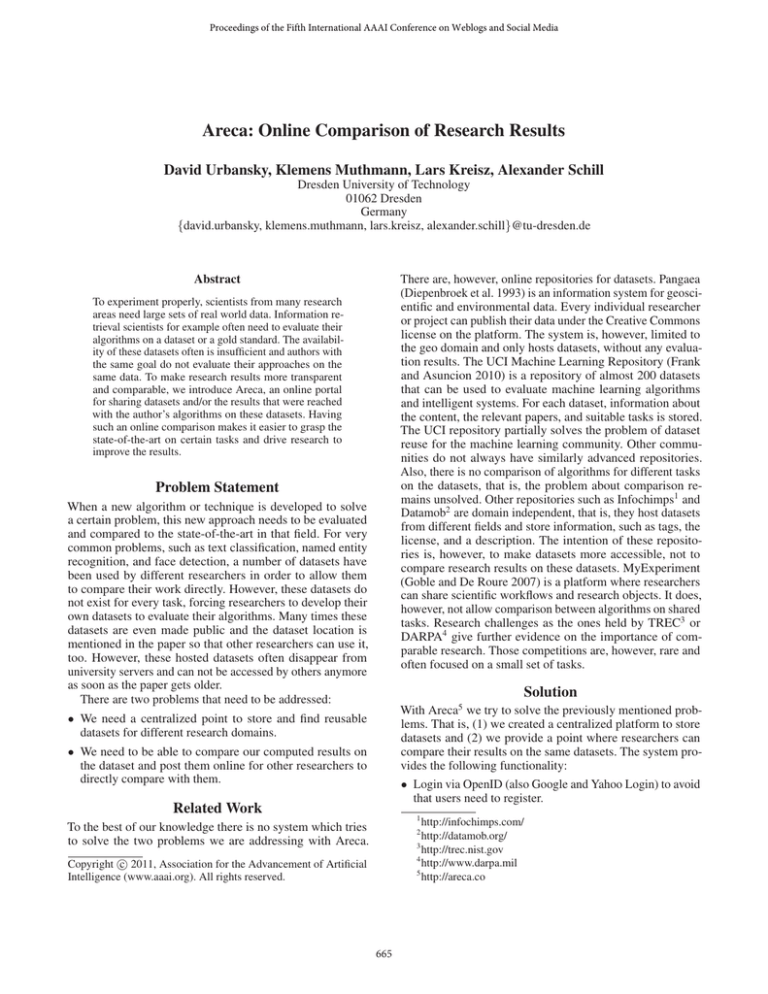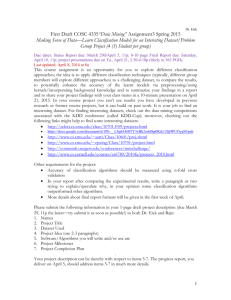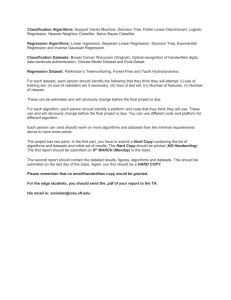
Proceedings of the Fifth International AAAI Conference on Weblogs and Social Media
Areca: Online Comparison of Research Results
David Urbansky, Klemens Muthmann, Lars Kreisz, Alexander Schill
Dresden University of Technology
01062 Dresden
Germany
{david.urbansky, klemens.muthmann, lars.kreisz, alexander.schill}@tu-dresden.de
There are, however, online repositories for datasets. Pangaea
(Diepenbroek et al. 1993) is an information system for geoscientific and environmental data. Every individual researcher
or project can publish their data under the Creative Commons
license on the platform. The system is, however, limited to
the geo domain and only hosts datasets, without any evaluation results. The UCI Machine Learning Repository (Frank
and Asuncion 2010) is a repository of almost 200 datasets
that can be used to evaluate machine learning algorithms
and intelligent systems. For each dataset, information about
the content, the relevant papers, and suitable tasks is stored.
The UCI repository partially solves the problem of dataset
reuse for the machine learning community. Other communities do not always have similarly advanced repositories.
Also, there is no comparison of algorithms for different tasks
on the datasets, that is, the problem about comparison remains unsolved. Other repositories such as Infochimps1 and
Datamob2 are domain independent, that is, they host datasets
from different fields and store information, such as tags, the
license, and a description. The intention of these repositories is, however, to make datasets more accessible, not to
compare research results on these datasets. MyExperiment
(Goble and De Roure 2007) is a platform where researchers
can share scientific workflows and research objects. It does,
however, not allow comparison between algorithms on shared
tasks. Research challenges as the ones held by TREC3 or
DARPA4 give further evidence on the importance of comparable research. Those competitions are, however, rare and
often focused on a small set of tasks.
Abstract
To experiment properly, scientists from many research
areas need large sets of real world data. Information retrieval scientists for example often need to evaluate their
algorithms on a dataset or a gold standard. The availability of these datasets often is insufficient and authors with
the same goal do not evaluate their approaches on the
same data. To make research results more transparent
and comparable, we introduce Areca, an online portal
for sharing datasets and/or the results that were reached
with the author’s algorithms on these datasets. Having
such an online comparison makes it easier to grasp the
state-of-the-art on certain tasks and drive research to
improve the results.
Problem Statement
When a new algorithm or technique is developed to solve
a certain problem, this new approach needs to be evaluated
and compared to the state-of-the-art in that field. For very
common problems, such as text classification, named entity
recognition, and face detection, a number of datasets have
been used by different researchers in order to allow them
to compare their work directly. However, these datasets do
not exist for every task, forcing researchers to develop their
own datasets to evaluate their algorithms. Many times these
datasets are even made public and the dataset location is
mentioned in the paper so that other researchers can use it,
too. However, these hosted datasets often disappear from
university servers and can not be accessed by others anymore
as soon as the paper gets older.
There are two problems that need to be addressed:
Solution
5
With Areca we try to solve the previously mentioned problems. That is, (1) we created a centralized platform to store
datasets and (2) we provide a point where researchers can
compare their results on the same datasets. The system provides the following functionality:
• We need a centralized point to store and find reusable
datasets for different research domains.
• We need to be able to compare our computed results on
the dataset and post them online for other researchers to
directly compare with them.
• Login via OpenID (also Google and Yahoo Login) to avoid
that users need to register.
Related Work
1
http://infochimps.com/
http://datamob.org/
3
http://trec.nist.gov
4
http://www.darpa.mil
5
http://areca.co
To the best of our knowledge there is no system which tries
to solve the two problems we are addressing with Areca.
2
c 2011, Association for the Advancement of Artificial
Copyright Intelligence (www.aaai.org). All rights reserved.
665
Figure 1: Search for a Dataset or Result.
• Fulltext search of dataset descriptions and tags.
• Upload and edit a dataset. The author can either upload
the dataset directly from their disk, upload it by providing
a URL, or simply referring to a dataset by linking it. The
author can provide a description of the dataset in Wiki
notation, add tags, and choose a license.
• Create and edit tasks. On a single dataset there could be
different tasks that are of interest. For example, on a dataset
of English newspaper articles, the task could be to classify
the articles by topic or extract named entities.
Figure 2: Comparing Text Classification Algorithms on a
Dataset.
• Add results to tasks. The main innovation of Areca is that
authors can now post their results on the created tasks. For
each result a number of traits can be created. For example,
an author could post what their classification accuracy
(trait) on the classification task of the newspaper dataset is.
and in which paper she finds more about the approach. She
now runs her own algorithm on the dataset following the
instructions of the task and publish her results on the same
page as well. Furthermore, when publishing her results in a
paper, she points to this result and comparison page. Alice
does not have to host the dataset and/or her results on her
own web server that might be inaccessible in the near future.
• Visualize results on tasks. Results from all authors on a
given task are visualized and compared against each other
on each defined trait.
• Each result can link to a paper explaining the methods in
detail. The paper information does not have to be pasted
into the system when the author is a member of the research
community Mendeley. In that case the information can
directly be retrieved from the Mendeley API6 .
Conclusion and Outlook
In this paper, we introduced Areca, an online repository for
research datasets and evaluation results. Our goal is to make
research results more comparable and make it easier to find
state-of-the-art algorithms on research problems. Areca is
work in progress. The next step is to ensure that researchers
publish correct results. Since everybody can post basically
anything, we need a trust system that researchers can use.
One idea is to use the community and give them the ability
to “distrust a result”. If too many researchers do not trust a
result it will be removed unless the proper evidence is shown.
Another idea we’re looking into is having multiple instances
of Areca so that each research group can have its own that
can be synchronized to the global instance.
Scenario
Let us consider the following scenario. The researcher Alice
has an idea for an algorithm for text classification. Before she
starts experimenting, Alice needs to know which algorithms
are the best so far and, therefore, what her baseline should
be. She would need to read the most recent papers about text
classification and hope that they compared their algorithms
with the current state-of-the-art. The next step would be finding datasets on which she could run her algorithms on. Again,
papers by other researchers might give her hints about what
can be used and where it can be found. After finally finding
the latest research results, the description of the algorithms,
and hopefully some datasets, she can start comparing her approach to existing ones manually. Alice now may publish her
findings, hoping that other researchers will find her results.
The same process can be simplified with Areca. The search
starts with “text classification“ on the platform as shown in
Figure 1. Alice now sees all datasets that were used for the
task and all the evaluations of the algorithms. Figure 2 shows
the comparison page of different algorithms on one task and
dataset7 . On this page, Alice determines which algorithm
performs best for a task, who the authors of the result are,
6
7
References
Diepenbroek, M.; Grobe, H.; Schindler, U.; and Sieger, R.
1993. Publishing network for geoscientific environmental
data. http://www.pangaea.de/.
Frank, A., and Asuncion, A. 2010. UCI machine learning
repository. http://archive.ics.uci.edu/ml.
Goble, C., and De Roure, D. 2007. myExperiment: social
networking for workflow-using e-scientists. In Proceedings
of the 2nd workshop on Workflows in support of large-scale
science, 1–2. ACM.
http://dev.mendeley.com/
http://areca.co/2/20-Newsgroups-Dataset/Text-Classification
666





